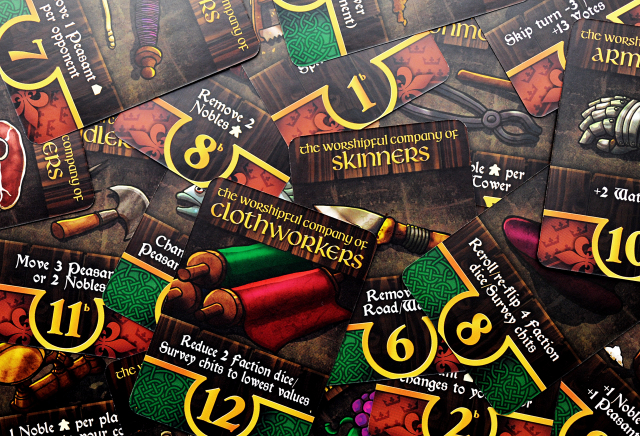The Walled City by Daryl Andrews and Stephen Sauer is two games in one, or at least two versions in one. The double sided board allows you to play in the small village of Londonderry or flip it over to tackle The Border Lands of Neuf Brisach.
The rules of The Walled City are actually pretty simple, but that belies the depth of strategy hiding just below the surface. The city of Londonderry is being divided into districts. Controlling those districts and the Factions living there with your Nobles and Peasants will earn you votes (points). You play through two rounds with a scoring after each round.
One of the cool elements of this game is that it is multi tiered area control. You’re trying to have majorities in several different places that are constantly shifting size and shape. Not only that, you’re trying to control Factions that start off with a random point value, but that will be changing throughout the game too! It is an ever shifting tug of war. No two games are ever going to be the same. If you’re like me as soon as your first game is done you’re going to want to play again immediately and try out another approach to this complex puzzle.

At the beginning of the game the board is relatively empty. There are some outer walls built, but the town itself is a wide open space. There are 20 Faction Dice in five different colours. Each worth 1-3 points. They get randomly put out on the on designated spots in the city and on the surrounding Towers. Counting only the dice within the city walls establishes a starting value for each Faction. There are also some survey chits that can add or decrease the value of a district by a point. There are four phases to each round.
In the Alignment phase players will take turns selecting from the randomly available Guilds. Guilds, like the Skinners or Haberdashers, have a (usually) single use ability to help you during the round. They also have a initiative number that sets the turn order for the round. The unchosen Guilds will be put aside until the Alignment phase of round two.
The Building phase is where the meat of the action takes place. In the first round a turn consists of playing a road that divides the city into smaller parts and creates new districts. You then get to play a Construction Card. Construction Cards have a number on both ends. This indicates how many citizens may be placed on either side of the road that was just added. For example if you played a 2/1 card you would put 2 citizens down on one side of the road and 1 on the other. It’s up to you whether they are Nobles or Peasants. In terms of majority of an area they both count the same, but Nobles will break ties and they are the only ones that can be promoted to the towers…don’t worry we’ll get to that. Finally you get to adjust a Faction Die by 1 point or flip a survey chit. Players continue until all their roads have been added to the board.
In the Count Votes phase control of the newly created districts will be assessed. Having the majority in a district will gain you 5 points, second will get you 3 and third will get you one point. You’ll also score out control of the different factions. Whoever has the most citizens dedicated to the different factions earns votes equal to the faction value.
The Defence phase ends both rounds. Going in reverse score order players select a Construction Card from their hand to play in one of the available tower defence spaces affecting the two adjacent towers. This will add to the overall value of the Tower during end game scoring.
In round two most of the phases are the same with a few exceptions. You take into account all the Faction Dice when assessing Faction value, including the dice on the wall surrounding the city. During the Build phase players are adding Walls to protect the city instead of Roads. Construction Cards allow you to add citizens to the district that the Wall borders and promote a certain number of Nobles to adjacent Towers. Before counting votes any Noble whose district is not completely closed off from the horrors of the outside world will flee from the not-so-walled city, never to return (or be counted towards majority). There is a final Defence phase and then the defence cards are flipped and votes are awarded for the Tower majorities.

The Borderlands side of the board plays in the same way, but with some interesting graphical differences. Some intersections come to a T allowing you to choose from three different districts when placing your citizens. You’re also going to start with a different number of roads.
Joshua Cappel’s art for The Walled City is amazing! The double sided board gives two unique play experiences but also visually feel like an entirely different world. You truly get the sense you’re actually building up a new city as you add roads, walls and citizens. The Faction Dice are colourful and you can easily assess their value. Your Nobles and Peasants are meeples and little wooden shacks respectively. The walls are cool, solid wooden stands. By the end of a game of The Walled City your board will be alive with bits, each piece an important factor in determining control of an area.
I was a pretty big fan of The Walled City, even though my brain is still recovering. It’s the kind of game that promotes discussion afterwards and analysis about what went right or wrong for you (in my case, a lot). During a turn, it’s very limited what you can actually do, but the ramifications of most actions reverberate throughout the rest of the game. This can lead to longer turns, but each action changes the board so dramatically, you’re going to want to pay attention to the other players’ moves. I really think The Walled City has the potential to be considered a modern classic. I will continue to dissect and refine strategy in future games, analyzing the right or wrong moves I made along the way. Any game that can make you do that and keep you coming back for more is a winner!
Comments
No comments yet! Be the first!